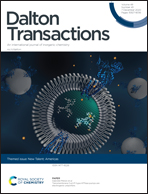Silver(i) complexes of 3-methoxy-4-hydroxybenzaldehyde thiosemicarbazones and triphenylphosphine: structural, cytotoxicity, and apoptotic studies†
Abstract
Novel silver(I) complexes of the type [AgCl(PPh3)2(L)] {PPh3 = triphenylphosphine; L = VTSC = 3-methoxy-4-hydroxybenzaldehyde thiosemicarbazone (1); VMTSC = 3-methoxy-4-[2-(morpholine-1-yl)ethoxy]benzaldehyde thiosemicarbazone (2); VPTSC = 3-methoxy-4-[2-(piperidine-1-yl)ethoxy]benzaldehyde thiosemicarbazone (3)} were synthesized and fully characterized by spectroscopic techniques. The molecular structures of complexes 2 and 3 were determined by single crystal X-ray diffraction. Compounds 1–3 exhibited appreciable cytotoxic activity against human tumor cells (lung A549, breast MDA-MB-231 and MCF-7) with IC50 values in 48 h of incubation ranging from 5.6 to 18 μM. Cellular uptake studies showed that complexes 1–3 were efficiently internalized after 3 hours of treatment in MDA-MB-231 cells. The effects of complex 1 on the cell morphology, cell cycle, induction of apoptosis, mitochondrial membrane potential (Δψm), and reactive oxygen species (ROS) production have been evaluated in triple negative breast cancer (TNBC) cells MDA-MB-231. Our results showed that complex 1 induced typical morphological alterations of cell death, an increase in cells at the sub-G1 phase, apoptosis, and mitochondrial membrane depolarization. Furthermore, DNA binding studies evidenced that 1 can bind to ct-DNA and does so without modifying the B-structure of the DNA, but that the binding is weak compared to that of Hoechst 33258.

- This article is part of the themed collection: New Talent: Americas


 Please wait while we load your content...
Please wait while we load your content...